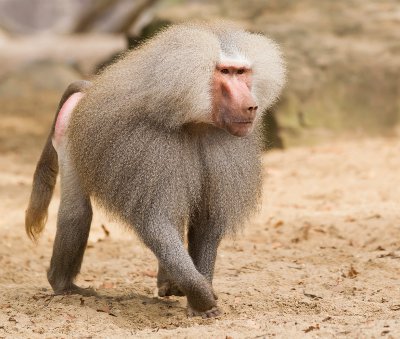Hamadryas Baboon
Category: Monkeys

Facts about Hamadryas Baboons. Hamadryas Baboon is a variety of Old World monkey that belongs to the genus Papio of the Cercopithecidae family. "Scientific name for Hamadryas Baboon is Papio Hamadryas". Hamadryas Baboon are also called as the sacred baboon because these baboons are considered sacred animals to the antique Egyptians and they emerge in different roles in the Egyptian culture. The Hamadryas Baboons hail from the Horn of Africa and they are largely found in the southwestern tilt of the Arabian Peninsula. These areas offer homes with the benefit of this species of less natural predators than southern or central Africa where other baboons live.
Features of Hamadryas Baboon
Usually, an adult male Hamadryas Baboon is twice as big as females, with the body length of 31 inches (80 cm), whereas the females have a body length that ranges from 16 inches to 18 inches (40 cm to 45 cm). The male Hamadryas Baboon also dominate the females in terms of body mass, ranging from 44 pounds to 66 pounds (20 kg to 30 kg). The tail of the Hamadryas Baboons further increases their body length, ranging from 16 inches to 24 inches (40 cm to 60 cm), and their tail ends in a small bunch.
Aside from the outstanding size difference between the genders, which is general to all baboons, the Hamadryas Baboon variety also demonstrates sexual dimorphism in their body coloration. The male Hamadryas Baboon has silver-white color fur and they have a marked cape, which grows when they attain the age of ten years, whereas the female Hamadryas Baboon have brown color fur and they have no cape. Their faces also vary in color from red to brown to a dark tan.
The range of the Hamadryas Baboon widens from the Red Sea in Eritrea to Djibouti, Ethiopia and Somalia. They also live in the southwestern parts of Arabia, in both Saudi Arabia and Yemen. The Hamadryas Baboons live in semi-desert regions, savannas and rock-strewn regions, requiring cliffs for finding water and sleeping.
Diet of Hamadryas Baboon
The Hamadryas Baboon is an omnivorous animal and it is tailored to its moderately dry habitat. During the damp seasons, they feed on a mixture of foods, including seeds, blossoms, grasses, leaves of the acacia trees and wild roots. During the summer season, they feed on the leaves. The Hamadryas Baboon also feed on insects, small creatures and reptiles.
Behavior of Hamadryas Baboon
The Hamadryas Baboon has a strange four-stage social system known as a multilevel civilization. Nearly all social interactions will take place in small groups known as one-male units or harems including one male baboon and a maximum of 10 female baboons in which the male Hamadryas Baboons will lead and act as a protector. A harem will normally contain a younger male admirer who may be associated with the leader. Two or more than two harems join frequently to shape clans. Inside clans, the leading male Baboon of the units are most likely close relations with one another and have an age-associated supremacy hierarchy
The drinking behavior of the Hamadryas Baboon counts on the season. During the damp seasons, the Hamadryas Baboons will not move far to find ponds for water. During the arid seasons, they frequently move to a maximum of three permanent waterholes. The Hamadryas Baboons will also excavate drinking holes at a short distance from the normal waterholes. They will take a rest at the waterholes throughout the mid - afternoon.
Reproduction of Hamadryas Baboon
Usually, the male Hamadryas Baboon attains the sexual maturity after 81 months of their birth, whereas the females will attain the sexual maturity after 51 months of their birth. The Hamadryas Baboons use to breed seasonally and the leading male monkey of a one-male unit does the majority of the mating, although other male baboons may also rarely sneak in copulations. The baby Hamadryas Baboons will bear a dark color body and this darkness will become pale after a year of their birth.
The maximum lifespan of the Hamadryas Baboon is 35 years.

 Back To Category Monkeys
Back To Category Monkeys